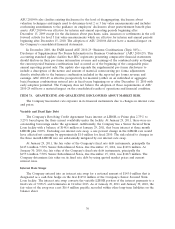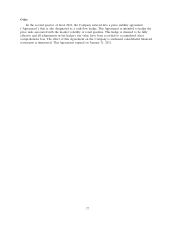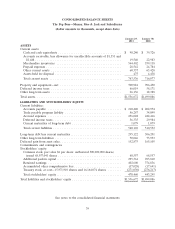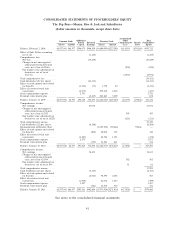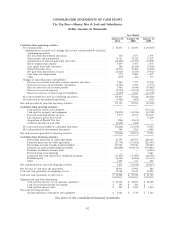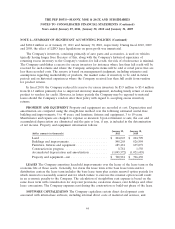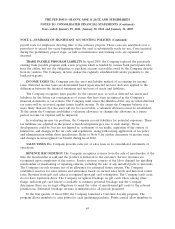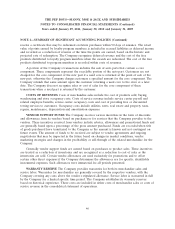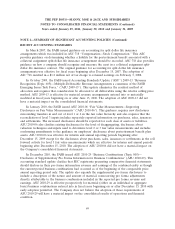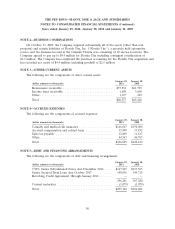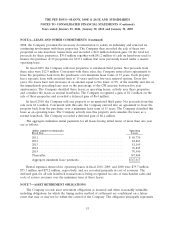Pep Boys 2010 Annual Report Download - page 102
Download and view the complete annual report
Please find page 102 of the 2010 Pep Boys annual report below. You can navigate through the pages in the report by either clicking on the pages listed below, or by using the keyword search tool below to find specific information within the annual report.
THE PEP BOYS—MANNY, MOE & JACK AND SUBSIDIARIES
NOTES TO CONSOLIDATED FINANCIAL STATEMENTS (Continued)
Years ended January 29, 2011, January 30, 2010 and January 31, 2009
NOTE 1—SUMMARY OF SIGNIFICANT ACCOUNTING POLICIES (Continued)
and $482.0 million as of January 29, 2011 and January 30, 2010, respectively. During fiscal 2010, 2009
and 2008, the effect of LIFO layer liquidations on gross profit was immaterial.
The Company’s inventory, consisting primarily of auto parts and accessories, is used on vehicles
typically having longer lives. Because of this, along with the Company’s historical experience of
returning excess inventory to the Company’s vendors for full credit, the risk of obsolescence is minimal.
The Company establishes a reserve for excess inventory for instances where less than full credit will be
received for such returns and where the Company anticipates items will be sold at retail prices that are
less than recorded costs. The reserve is based on management’s judgment, including estimates and
assumptions regarding marketability of products, the market value of inventory to be sold in future
periods and on historical experiences where the Company received less than full credit from vendors
for product returns.
In fiscal 2010, the Company reduced its reserve for excess inventory by $5.9 million to $5.4 million
from $11.3 million primarily due to improved inventory management, including timely return of excess
product to vendors for credit. However, in future periods the Company may be exposed to material
losses should the Company’s vendors alter their policy with regard to accepting excess inventory
returns.
PROPERTY AND EQUIPMENT Property and equipment are recorded at cost. Depreciation and
amortization are computed using the straight-line method over the following estimated useful lives:
building and improvements, 5 to 40 years, and furniture, fixtures and equipment, 3 to 10 years.
Maintenance and repairs are charged to expense as incurred. Upon retirement or sale, the cost and
accumulated depreciation are eliminated and the gain or loss, if any, is included in the determination
of net income. Property and equipment information follows:
January 29, January 30,
(dollar amounts in thousands) 2011 2010
Land ...................................... $ 204,023 $ 204,709
Buildings and improvements ...................... 848,268 826,804
Furniture, fixtures and equipment .................. 685,481 695,072
Construction in progress ........................ 8,781 1,550
Accumulated depreciation and amortization .......... (1,045,572) (1,021,685)
Property and equipment—net ..................... $ 700,981 $ 706,450
LEASES The Company amortizes leasehold improvements over the lesser of the lease term or the
economic life of those assets. Generally, for stores the lease term is the base lease term and for
distribution centers the lease term includes the base lease term plus certain renewal option periods for
which renewal is reasonably assured and for which failure to exercise the renewal option would result
in an economic penalty to the Company. The calculation of straight-line rent expense is based on the
same lease term with consideration for step rent provisions, escalation clauses, rent holidays and other
lease concessions. The Company expenses rent during the construction or build-out phase of the lease.
SOFTWARE CAPITALIZATION The Company capitalizes certain direct development costs
associated with internal-use software, including external direct costs of material and services, and
44




